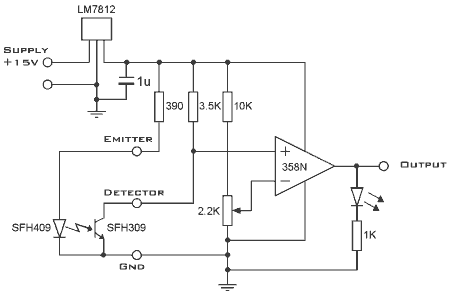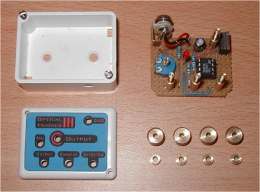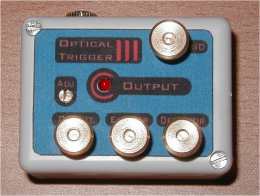
|
Optical Trigger Module This optical trigger is a general purpose module for use with 'standard' 3mm package infrared diode emitters and corresponding matched phototransistors. The emitter terminal on the module will source about 27mA to ground with a 1.2 V drop across the diode. The detector terminal will source a maximum of 3.4 mA to ground (short circuit). The circuit operates by sensing the voltage difference between the potentiometer (ADJ) level and the detector level. The circuit diagram is.
The circuit operates by detecting the voltage at the Detector terminal and comparing it to the preset voltage level. When there is nothing blocking the light path from the emitter to the detector, the phototransistor is conducting and the voltage at the detector terminal is low. In this state the output from the opamp is low. When the light path is blocked by the projectile, the phototransistor conduction decreases and the voltage at the detector terminal increases. This creates a positive difference between the opamp inputs and the output goes high. The ADJ 2.2K trimmer pot allows some adjustment of the triggering point to accommodate variations in the emitter-detector setup. Power is supplied via a 3mm/1/8" jack socket. The supply is internally regulated at 12V. The LED indicates whether the output is high - a helpful feature if a fault occurs in the optical gate. The component parts and assembled module are shown below.
While this is a very basic module it sufficient for preliminary experimentation. The module is limited by the switching speed of the phototransistor and the slew rate of the opamp. Typical switching speeds of phototransistors can be anything from ten to a hundred micro seconds depending on the circuit arrangement. This system is suitable for velocities up to about 50m/s. If a faster device is required then a photodiode system can be implemented. The switching time of a photodiode is in the nano second range but the photovoltage is very small. This requires more critical signal processing than the phototransistor setup. Opto modules for future high velocity coilguns will be based on photodiode detectors and high speed comparitor opamps.
|
|




